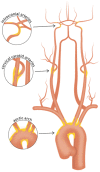Vessel wall MR imaging of aortic arch, cervical carotid and intracranial arteries in patients with embolic stroke of undetermined source: A narrative review
- PMID: 35968273
- PMCID: PMC9366886
- DOI: 10.3389/fneur.2022.968390
Vessel wall MR imaging of aortic arch, cervical carotid and intracranial arteries in patients with embolic stroke of undetermined source: A narrative review
Abstract
Despite advancements in multi-modal imaging techniques, a substantial portion of ischemic stroke patients today remain without a diagnosed etiology after conventional workup. Based on existing diagnostic criteria, these ischemic stroke patients are subcategorized into having cryptogenic stroke (CS) or embolic stroke of undetermined source (ESUS). There is growing evidence that in these patients, non-cardiogenic embolic sources, in particular non-stenosing atherosclerotic plaque, may have significant contributory roles in their ischemic strokes. Recent advancements in vessel wall MRI (VW-MRI) have enabled imaging of vessel walls beyond the degree of luminal stenosis, and allows further characterization of atherosclerotic plaque components. Using this imaging technique, we are able to identify potential imaging biomarkers of vulnerable atherosclerotic plaques such as intraplaque hemorrhage, lipid rich necrotic core, and thin or ruptured fibrous caps. This review focuses on the existing evidence on the advantages of utilizing VW-MRI in ischemic stroke patients to identify culprit plaques in key anatomical areas, namely the cervical carotid arteries, intracranial arteries, and the aortic arch. For each anatomical area, the literature on potential imaging biomarkers of vulnerable plaques on VW-MRI as well as the VW-MRI literature in ESUS and CS patients are reviewed. Future directions on further elucidating ESUS and CS by the use of VW-MRI as well as exciting emerging techniques are reviewed.
Keywords: atherosclerosis; cerebrovascular disease/stroke; embolic stroke of undetermined source (ESUS); imaging; stroke; vessel wall MRI.
Copyright © 2022 Sakai, Lehman, Eisenmenger, Obusez, Kharal, Xiao, Wang, Fan, Cucchiara and Song.
Conflict of interest statement
The authors declare that the research was conducted in the absence of any commercial or financial relationships that could be construed as a potential conflict of interest.
Figures










Similar articles
-
The role of cross-sectional imaging of the extracranial and intracranial vasculature in embolic stroke of undetermined source.Front Neurol. 2022 Aug 26;13:982896. doi: 10.3389/fneur.2022.982896. eCollection 2022. Front Neurol. 2022. PMID: 36090870 Free PMC article. Review.
-
MR imaging of vulnerable carotid plaque.Cardiovasc Diagn Ther. 2020 Aug;10(4):1019-1031. doi: 10.21037/cdt.2020.03.12. Cardiovasc Diagn Ther. 2020. PMID: 32968658 Free PMC article. Review.
-
Prevalence of ipsilateral "vulnerable carotid plaques with <50 % stenosis" on CT angiography in embolic stroke of undetermined source.J Neurol Sci. 2024 Dec 15;467:123316. doi: 10.1016/j.jns.2024.123316. Epub 2024 Nov 20. J Neurol Sci. 2024. PMID: 39580929 Clinical Trial.
-
Prevalence of Ipsilateral Nonstenotic Carotid Plaques on Computed Tomography Angiography in Embolic Stroke of Undetermined Source.Stroke. 2020 Jun;51(6):1743-1749. doi: 10.1161/STROKEAHA.120.029404. Epub 2020 May 7. Stroke. 2020. PMID: 32375585 Clinical Trial.
-
Carotid Intraplaque Hemorrhage in Patients with Embolic Stroke of Undetermined Source.J Stroke Cerebrovasc Dis. 2018 Jul;27(7):1956-1959. doi: 10.1016/j.jstrokecerebrovasdis.2018.02.042. Epub 2018 Mar 20. J Stroke Cerebrovasc Dis. 2018. PMID: 29571754
Cited by
-
Patent Foramen Ovale and Other Cardiopathies as Causes of Embolic Stroke With Unknown Source.J Stroke. 2024 Sep;26(3):349-359. doi: 10.5853/jos.2024.02670. Epub 2024 Sep 30. J Stroke. 2024. PMID: 39396831 Free PMC article. Review.
-
Cryptogenic stroke as a working diagnosis: the need for an early and comprehensive diagnostic work-up.BMC Neurol. 2023 Apr 14;23(1):153. doi: 10.1186/s12883-023-03206-6. BMC Neurol. 2023. PMID: 37060045 Free PMC article.
-
Diagnostic Yield of High-Resolution Vessel Wall Magnetic Resonance Imaging in the Evaluation of Young Stroke Patients.J Clin Med. 2023 Dec 29;13(1):189. doi: 10.3390/jcm13010189. J Clin Med. 2023. PMID: 38202196 Free PMC article.
References
Publication types
LinkOut - more resources
Full Text Sources
Miscellaneous

